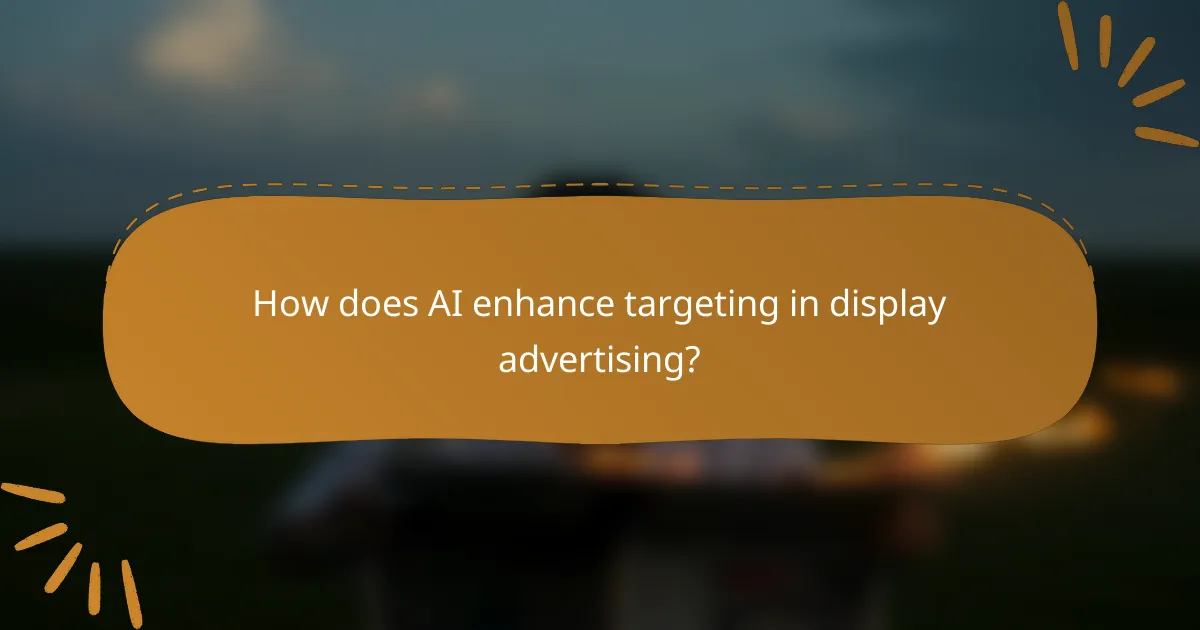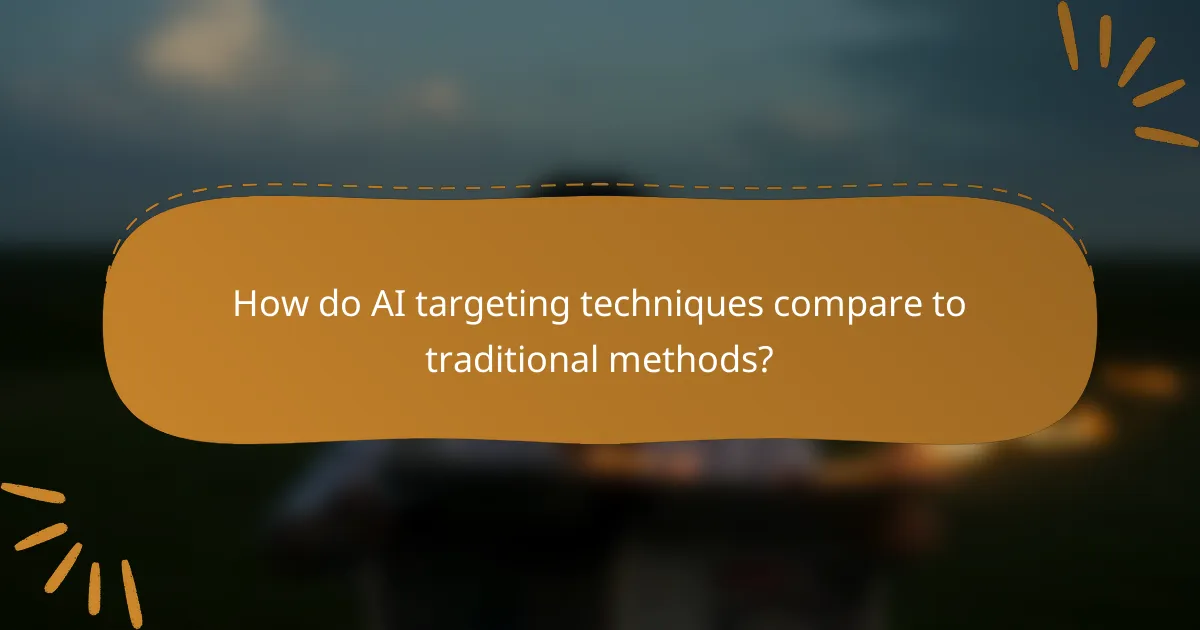AI is revolutionizing display advertising by employing sophisticated algorithms to analyze extensive data, allowing advertisers to effectively target specific audiences. This advanced targeting not only enhances engagement and conversion rates but also significantly improves campaign performance, resulting in higher ROI and more efficient ad spending.

How does AI enhance targeting in display advertising?
AI enhances targeting in display advertising by utilizing advanced algorithms to analyze vast amounts of data, enabling advertisers to reach specific audiences more effectively. This technology allows for more precise ad placements, optimizing engagement and conversion rates.
Improved audience segmentation
AI improves audience segmentation by analyzing user behavior, demographics, and interests to create detailed profiles. This enables advertisers to tailor their campaigns to specific groups, increasing the relevance of ads shown to users. For instance, a fashion retailer might target ads based on browsing history, ensuring that users see products aligned with their preferences.
Utilizing machine learning, AI can continuously refine these segments, adapting to changes in user behavior over time. This dynamic approach helps maintain engagement and reduces ad fatigue, as users are more likely to respond to personalized content.
Real-time data analysis
AI’s capability for real-time data analysis allows advertisers to make swift adjustments to their campaigns based on current performance metrics. By monitoring key indicators like click-through rates and conversion rates, AI can identify which ads are performing well and which are not, facilitating immediate optimization.
This responsiveness is crucial in the fast-paced digital landscape, where trends can change rapidly. For example, if a specific ad is underperforming, AI can suggest modifications or reallocate budget to higher-performing ads, maximizing overall campaign effectiveness.
Predictive analytics for ad performance
Predictive analytics powered by AI can forecast future ad performance based on historical data and current trends. By analyzing patterns, AI can estimate how different segments will respond to specific ads, allowing advertisers to allocate resources more effectively.
For instance, if data shows that a particular demographic is likely to convert at a higher rate during certain times of the year, advertisers can plan their campaigns accordingly. This proactive approach not only enhances ROI but also helps in crafting more compelling ad strategies tailored to audience expectations.

What are the benefits of AI targeting techniques?
AI targeting techniques offer significant advantages for advertisers by enhancing the precision of audience reach and improving overall campaign performance. These benefits include increased return on investment (ROI), higher engagement rates, and cost efficiency in ad spending.
Increased ROI for advertisers
AI targeting techniques can dramatically boost ROI by ensuring that ads are shown to the most relevant audiences. By analyzing user behavior and preferences, AI can identify potential customers who are more likely to convert, leading to higher sales and better use of advertising budgets.
For example, advertisers using AI-driven platforms often see ROI improvements ranging from 20% to 50% compared to traditional targeting methods. This is achieved through continuous optimization of ad placements based on real-time data.
Higher engagement rates
Utilizing AI targeting techniques typically results in higher engagement rates as ads are tailored to individual user interests and behaviors. Personalized content resonates more with viewers, prompting them to interact with the advertisement.
Studies have shown that personalized ads can lead to engagement rates that are several times higher than generic ads. This increased interaction not only enhances brand visibility but also fosters customer loyalty.
Cost efficiency in ad spend
AI targeting techniques contribute to cost efficiency by minimizing wasted ad spend on irrelevant audiences. By focusing on users who are more likely to engage, advertisers can allocate their budgets more effectively, reducing overall costs per acquisition.
For instance, businesses may find that their cost per click (CPC) decreases significantly when using AI targeting, often dropping by 10% to 30%. This allows for a more strategic approach to ad spending, ensuring that every dollar is spent wisely.

Which AI tools are leading in display advertising?
Several AI tools are at the forefront of display advertising, significantly enhancing targeting and optimization. Key players include Google Ads, Adobe Advertising Cloud, and Facebook Ads, each offering unique features that leverage artificial intelligence to improve ad performance.
Google Ads AI features
Google Ads utilizes machine learning to optimize ad placements and targeting. Its Smart Bidding feature adjusts bids in real-time based on various signals, such as user behavior and demographics, aiming to maximize conversions while staying within budget.
Advertisers can benefit from responsive display ads, which automatically adjust their size, appearance, and format to fit available ad spaces. This flexibility can lead to improved engagement rates and better overall campaign performance.
Adobe Advertising Cloud
Adobe Advertising Cloud integrates AI to streamline campaign management across multiple channels. Its Audience Insights tool helps advertisers identify and target specific segments more effectively, using data analytics to refine audience profiles.
The platform’s automated bidding strategies enable users to set goals, such as maximizing return on ad spend (ROAS), while the AI continuously optimizes bids based on real-time performance data, ensuring efficient use of advertising budgets.
Facebook Ads AI capabilities
Facebook Ads employs AI to enhance targeting precision and ad relevance. The platform’s machine learning algorithms analyze user interactions to deliver personalized ad experiences, increasing the likelihood of engagement and conversions.
Dynamic ads allow advertisers to automatically show relevant products to users based on their previous interactions, making it easier to retarget potential customers. This capability can significantly boost conversion rates, especially in e-commerce settings.

What criteria should be used to select AI targeting solutions?
When selecting AI targeting solutions, consider integration with existing platforms, scalability, and data privacy compliance. These criteria ensure that the solution fits seamlessly into your current operations, can grow with your needs, and adheres to relevant regulations.
Integration with existing platforms
AI targeting solutions should easily integrate with your current marketing platforms, such as CRM systems and ad networks. Look for solutions that offer APIs or pre-built connectors to streamline data sharing and campaign management.
For example, if you use Google Ads, ensure the AI solution can directly pull data from your campaigns to optimize targeting. This integration reduces manual work and enhances the effectiveness of your advertising efforts.
Scalability of solutions
Choose AI targeting solutions that can scale as your business grows. This means they should handle increasing volumes of data and adapt to more complex targeting strategies without significant performance drops.
Consider solutions that offer tiered pricing models, allowing you to start small and expand features or capabilities as needed. This flexibility can help manage costs while ensuring you have the tools necessary for larger campaigns.
Data privacy compliance
Data privacy compliance is crucial when selecting AI targeting solutions, especially with regulations like GDPR in Europe and CCPA in California. Ensure that the solution adheres to these regulations to avoid legal issues and protect user data.
Look for solutions that provide clear data handling practices and allow users to manage their consent preferences. This transparency not only builds trust with your audience but also helps maintain compliance with evolving privacy laws.

How do AI targeting techniques compare to traditional methods?
AI targeting techniques offer significant advantages over traditional methods by enhancing efficiency, accuracy, and adaptability in advertising. While traditional methods often rely on broad demographics and static data, AI utilizes real-time analytics and machine learning to optimize ad placements and audience engagement.
Efficiency in ad placements
AI targeting techniques streamline ad placements by automating the process and reducing the time needed for manual adjustments. This efficiency allows advertisers to allocate their budgets more effectively, often leading to lower costs per acquisition compared to traditional methods.
For instance, AI can analyze vast amounts of data to determine the best times and platforms for ad placements, ensuring that ads reach the right audience at the right moment. This can result in a more efficient use of advertising spend, maximizing return on investment.
Accuracy in audience targeting
AI enhances accuracy in audience targeting by leveraging data analytics to identify specific user behaviors and preferences. Unlike traditional methods that may use generalized audience segments, AI can create detailed profiles based on real-time interactions, leading to more personalized advertising.
For example, AI can track user engagement across various channels and adjust targeting parameters dynamically, ensuring that ads resonate with the intended audience. This precision can lead to higher conversion rates and improved customer satisfaction.
Adaptability to market changes
AI targeting techniques are highly adaptable, allowing advertisers to respond quickly to market changes and consumer trends. In contrast, traditional methods often require longer lead times for adjustments, which can result in missed opportunities.
AI systems can continuously learn from new data, enabling them to refine targeting strategies in real-time. This adaptability is crucial in fast-paced markets, where consumer preferences can shift rapidly, ensuring that advertising efforts remain relevant and effective.

What are the emerging trends in AI targeting for display advertising?
Emerging trends in AI targeting for display advertising focus on enhancing user engagement through advanced data analysis and personalization. Techniques such as machine learning and predictive analytics are increasingly being utilized to tailor advertisements to individual preferences and behaviors.
Personalization through machine learning
Machine learning enables advertisers to analyze vast amounts of data to create personalized experiences for users. By examining past interactions, preferences, and demographic information, algorithms can predict what content will resonate most with specific audiences.
For instance, a clothing retailer might use machine learning to recommend products based on a user’s previous purchases and browsing history. This targeted approach can increase conversion rates significantly, as users are more likely to engage with ads that reflect their interests.
To effectively implement machine learning for personalization, businesses should ensure they have access to quality data and invest in robust analytical tools. Regularly updating models and testing different strategies can help optimize ad performance and improve user satisfaction.
